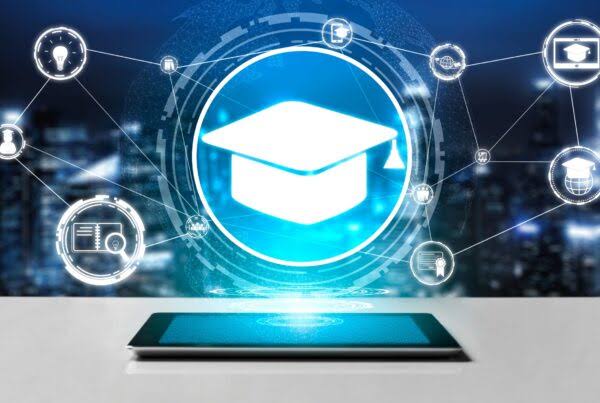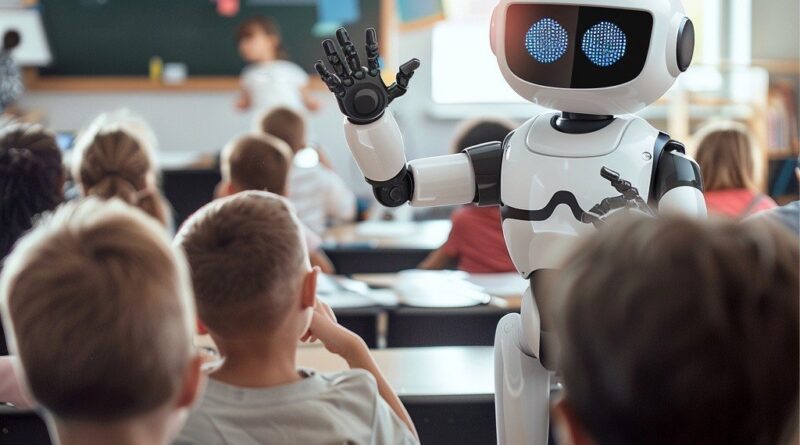AI in Education 2025: Smarter Learning for a Smarter Generation
“In 2025, AI makes education smarter, not harder — unlocking each child’s full potential.”
Artificial Intelligence (AI) has steadily permeated every aspect of our lives, and education is no exception. The All India Council for Technical Education (AICTE) has declared 2025 as the “Year of Artificial Intelligence”, aiming to integrate AI into India’s educational ecosystem. This initiative targets over 40 million students. However, concerns about data privacy, academic integrity, and ethical AI use require robust regulations to ensure responsible implementation.
AI is poised to refine personalized learning like never before. Advanced algorithms can analyze a student’s strengths, weaknesses, and interests to tailor individual learning paths. AI-powered platforms dynamically adjust lesson difficulty in real-time, helping to keep students engaged, challenged, and motivated. Smart classrooms powered by AI represent a transformative leap—enhancing content delivery, automating administrative tasks, and offering continuous, conversational support to both students and educators.
The COVID-19 pandemic significantly accelerated the adoption of AI in education. With schools shut down, institutions turned to digital platforms, using AI for virtual classrooms, automated assessments, and personalized learning support.
Next-Gen Education with AI
Globally, AI is reshaping education by enhancing personalization, improving efficiency, expanding access, and enabling data-driven decision-making. Countries like China, India, the U.S., and Canada treat AI not merely as a subject but as a strategic priority—partnering with tech firms and researchers to incorporate AI into school curricula.
In 2025, major players in AI education include Google, Microsoft, OpenAI, and EdTech companies like BYJU’S, Coursera, and Duolingo. Tech giants provide the infrastructure and AI-powered tools used in schools globally, while EdTech firms drive innovation in adaptive and personalized learning experiences.
Conversational AI and chatbots are revolutionizing classroom interactions. These tools can instantly evaluate responses, offer real-time feedback, and guide learners toward better understanding. For teachers, chatbots reduce administrative burdens, allowing more time for instructional and emotional support.
AI also helps track student progress, supports intelligent tutoring systems, and aids in curriculum design through real-time data analytics. Cross-border collaborations—training programs, global education trends, and international exposure—are further enhancing educational equity and innovation in 2025.
AI Enters Indian Classrooms
Traditional Indian classrooms emphasize discipline, values, and teacher-led instruction. However, AI integration is reshaping these spaces into dynamic, technology-driven environments.
The National Education Policy (NEP) 2020 supports the integration of AI, coding, and computational thinking into school curricula. A shining example is KTCT Higher Secondary School in Thiruvananthapuram, Kerala, which introduced “Iris”, India’s first AI teacher robot, developed by Maker Labs Edutech. It’s designed to provide personalized, interactive learning experiences.
India’s leading EdTech platforms—BYJU’S, Unacademy, Vedantu, Toppr, UpGrad, and PhysicsWallah—are expanding access to quality education across urban and rural areas. Additionally, the Andhra Pradesh government has signed a Memorandum of Understanding (MoU) with NVIDIA to establish an AI university in Amaravati, marking a significant step toward India’s AI-powered educational future.
Milagrow, a pioneer in service robotics, is expanding its ecosystem with Milagrow Education, aiming to bridge the gap between academic learning and real-world robotics application, preparing students with essential future-ready skills.

Challenges in AI Integration
While AI brings immense potential, it also presents real challenges:
- Overdependence on Technology: Excessive reliance on AI tools may weaken students’ critical thinking, problem-solving abilities, and creativity.
- Digital Divide: AI education demands substantial investment in infrastructure and training. This risks widening the gap between urban and rural or well-funded and underfunded schools.
- Privacy & Security: AI platforms collect vast amounts of personal data, raising serious concerns over data security and surveillance.
- Emotional Intelligence: AI lacks the empathy and nuanced understanding that human teachers offer. It cannot fully address students’ emotional needs or resolve social conflicts.
- Job Insecurity: Automation of tasks like grading and lesson planning may marginalize teachers, especially in rural areas where digital literacy is low.
- Ethical Concerns: Biased algorithms could lead to unfair academic assessments. Students might misuse AI tools for shortcuts, diminishing the learning process.
India must address these gaps through inclusive policies, strong regulatory frameworks, and teacher training programs to ensure equitable and ethical AI use.
India’s Rural Education and AI
Rural schools face infrastructural, financial, and technological hurdles. However, government schemes, NGOs, and EdTech platforms are working to improve access. Programs like mid-day meals, free education initiatives, and low-cost digital learning tools are gradually transforming rural education.
Nevertheless, teachers in rural areas often lack the digital skills and support needed to integrate AI effectively. If not addressed, AI could unintentionally reinforce existing inequalities rather than reduce them.
Global Trends: The Future of AI Education
China, once known for rote learning, has shifted toward AI-based personalized education. Chinese parents and schools are embracing AI to boost academic performance, and the country aims to fully integrate AI into its education system by 2035.
Globally, the EdTech and smart classroom market was valued at USD 155.42 billion in 2024, projected to grow to USD 545.65 billion by 2032, with a CAGR of 16.9%. In India, the EdTech market is currently valued at ₹64,875 crore (USD 7.5 billion) and is expected to grow significantly by 2030, as per the IAMAI and Grant Thornton Bharat.
The future of AI in education will feature:
- Intelligent Tutoring Systems
- Personalized Learning Platforms
- AR/VR for immersive experiences
- Natural Language Processing (NLP)
- Automated assessments and grading
- Blockchain for secure student records
- Emotional AI for student well-being
- Metaverse classrooms
- Robotic teaching assistants
Teachers will evolve into mentors and facilitators, focusing on emotional, social, and ethical development, while AI handles personalization and administration. Their role will be crucial in cultivating creativity, empathy, and critical thinking—skills AI cannot replicate.
Conclusion
AI is transforming the global education sector with unparalleled speed and innovation. In India, the fusion of AI with education offers promising prospects—from personalized learning and virtual classrooms to smart assessments and teacher empowerment.
Yet, to harness AI’s full potential, we must strike a careful balance between innovation and human interaction. With proper infrastructure, ethical oversight, and inclusive implementation, AI-powered education can usher in a future where learning is truly accessible, personalized, and impactful for every student.
For more such interesting blogs, please visit: https://vichaardhara.co.in


